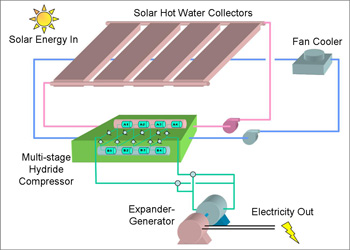Solar Thermal, Geothermal, Ocean Thermal Powered Electric Generators
Electricity from hot water? Absolutely!
This simple hydride heat engine prototype starts generating electricity the moment the hydride heat exchangers are dipped into hot and cold water. See it happen in this short video clip:
|
The hydride heat engine is comprised of solar hot water panels, a fan cooler or radiator, a hydride-based hydrogen compressor and an expander-generator set. The solar panels produce hot water using energy from the sun. The most economical use of solar energy is making hot water and flat plate solar collectors have been available for more than thirty years. The hot water is pumped to the hydrogen compressor, which is the heart of the system; it converts the thermal energy in hot water into work energy by compressing a gas. The compressed gas is expanded in a hydraulic motor-generator set that produces electricity, after which it returns to the compressor. |
|
The compressor works by, first, absorbing hydrogen gas directly into a metal material, thus forming an alloy of the metal and hydrogen called a “metal hydride”. This process occurs at ambient temperature and generates some heat, which is rejected to the ambient air via the fan cooler. The metal hydride material is contained within patented very-high-surface-area heat exchangers which are alternately heated and cooled by recirculating water.
After the hydrogen has been fully absorbed and the heat exchanger cooled, hot water from the flat plate solar collectors is circulated through the heat exchangers. While the overall pressure is low, the elevated temperature increases the hydrogen pressure inside of the heat exchangers at an exponential rate. The higher-pressure hydrogen is then passed through an expander-generator set, which spins to produce electricity, before returning to the compressor in its initial, uncompressed state.
The compression/expansion heat engine cycle can be repeated indefinitely. In this way, the hydrogen gas is simply a "working fluid" that is neither created nor consumed, but only pressurized and expanded. The hydraulic fluid provides a convenient, economical and leak-free method of harnessing the work energy in the gas.


